Objectives: Examining and Preparing for the Threat of Violence in the Workplace
- The instances of mass violence in the workplace have become more frequent;
- Mass shootings are currently one of the most dangerous and common examples of violence in public spaces;
- Nursing services were subjected to mass violence (mass shootings) 4 times in 2018 (Federal Bureau of Investigation, 2019);
- Preventive measures to ensure a proper response in the workplace have to be created.
Despite the attempts to reduce the exposure of citizens to the threats of mass violence in the workplace, the danger remains persistent. Out of 27 shooting incidents taken place in 2018, four (4) were registered in the hospital area (Federal Bureau of Investigation, 2019). Therefore, active steps are to be taken to prepare staff members to the threat of a mass shooting and instruct them on the actions to be taken to help patients survive. Additionally, while not having as detrimental as an effect as the danger mentioned above, the problem of bullying in the nursing setting also poses an issue that has to be handled.
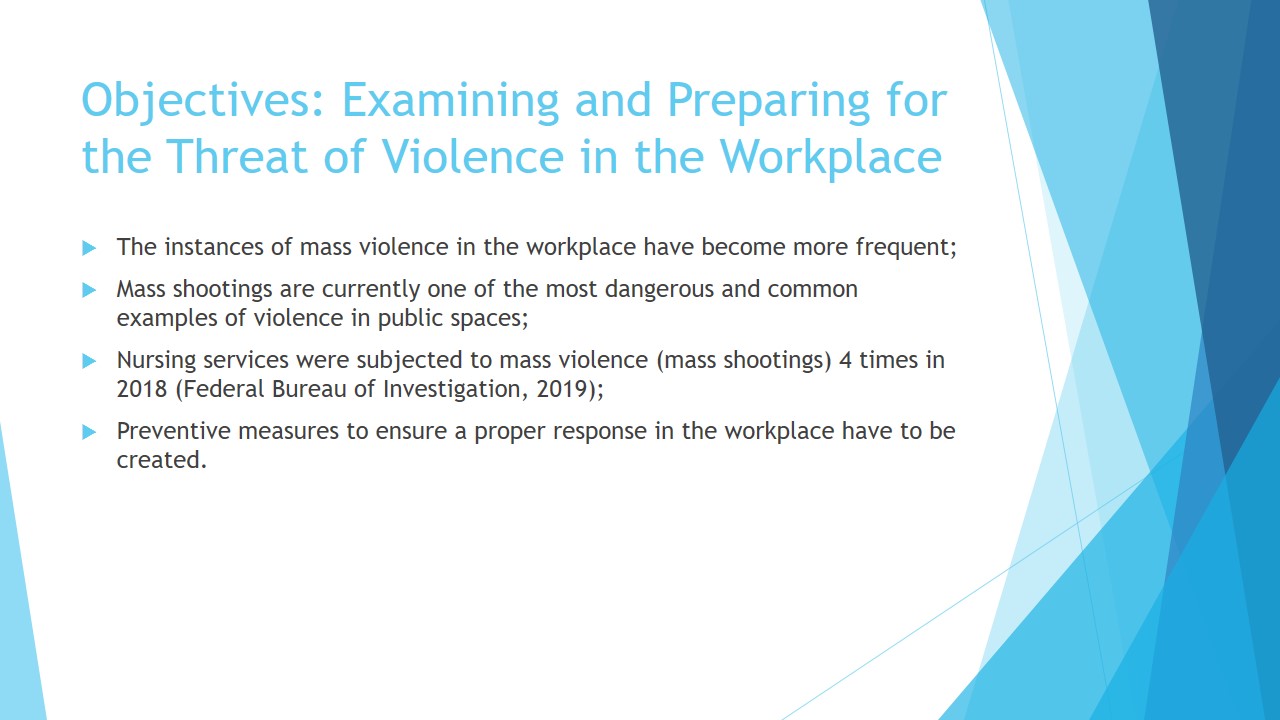
Preparing for an Active Shooter: Protocol and Crucial Steps to Ensure Patient Safety
- Key strengths of the protocol: presence of the “run, hide, fight” principle;
- Critical weaknesses of the protocol: absence of a delineated role of a nurse;
- Current problem of the protocol: lack of a detailed emergency plan;
- Primary goal: developing a system of responses toward the threat and outlining the role of nurses and their responsibilities.
Run → Hide → Fight
Addressing the threat of an active shooter in the nursing workplace, one will need to reconsider the existing protocol. The current framework is based on the “run, hide, fight” system designed and promoted by the Federal Bureau of Investigation (FBI) (International Association of Emergency Medical Services Chiefs, 2017). While meeting the established standards for preventing mass shootings, it could use improvements regarding the implementation process and tactical choices. For instance, the existing protocol should be reconsidered to include an extended role of a nurse and the actions that should and should not be taken.
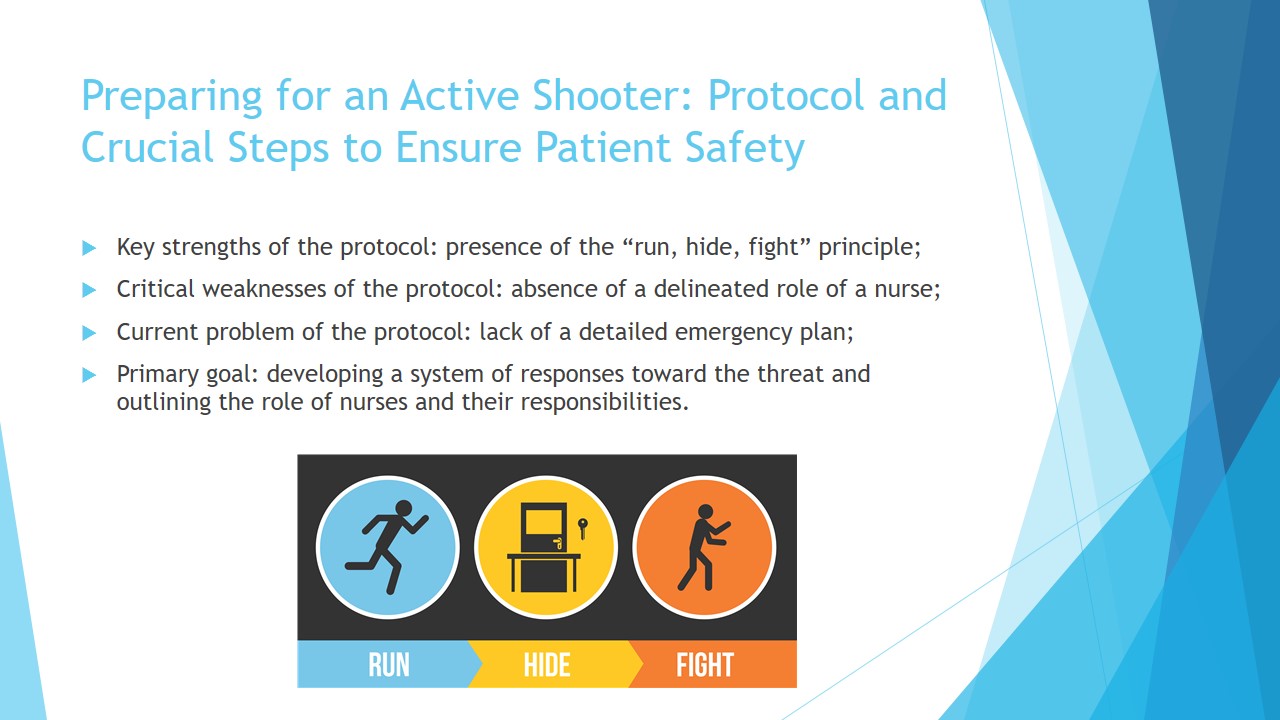
Preparing for an Active Shooter: Protocol and Crucial Steps to Ensure Personal Safety
- Drills: an important and effective way of assisting nurses in learning crucial strategies;
- Mannequins: tools for teaching nurses to apply basic strategies for tending to the needs of victims;
- Introduction of the “secure, preserve, fight” approach along with the standard “run, hide, fight” system;
- Emotional intelligence as the tool to address the needs of panicking patients;
- Emergency plans: a critical component of addressing an instance of a mass shooting and maintaining patient safety.
Active drills have to be introduced into the target setting for nurses to be able to recall key guidelines even under the pressure of the circumstances. During the drills, nurses will showcase their skills on realistic mannequins that will represent injured patients, as well as prove their ability to use emotional intelligence to reduce the level of hysteria among patients.
Moreover, emergency plans have to be developed, with clear and concise instructions and evacuation plans. It must become a nurse’s key responsibility to learn the primary responses to the threat of a shooting in the hospital and select the needed course of actions.
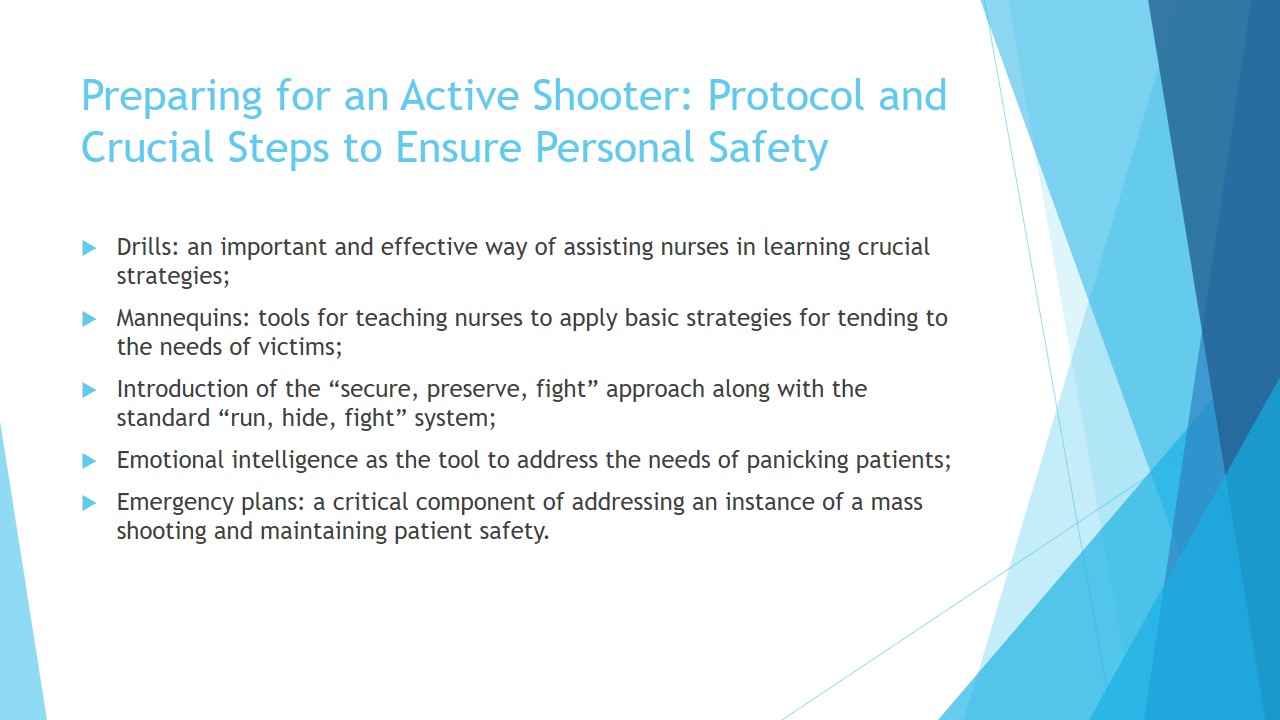
Preparing for an Active Shooter: Instructions for Nurses
- Imbuing the process of training with importance;
- Learning essential standards for evacuation and key evacuation routes;
- Providing guidelines for evacuating patients safely during the shooting;
- Instructing nurses about interactions with law enforcement units;
- Teaching strategies for hiding and fighting a perpetrator.
Secure. Securing the location → Protect. Focusing on a patient’s life → Fight. Fighting only when necessary.
Applying the threat of mass shooting to the target context, one may suggest emphasizing the importance of the corresponding guidelines by introducing a code name for them, such as “Code Silver.” The process should start with nurses about the strategies for evacuating patients immediately after a shooting has begun (International Association of Emergency Medical Services Chiefs, 2017). In the process, nurses have to be taught about the basic ways of interacting with the law enforcement unit, such as keeping hands up to avoid being mistaken for perpetrators. Similarly, nurses have to be taught strategies for hiding, as well as the methods of taking action. While the latter should be viewed only as the last resort since they suggest an immediate danger to a nurse’s life, the nursing staff has to receive basic information about the methods of incapacitating a shooter.
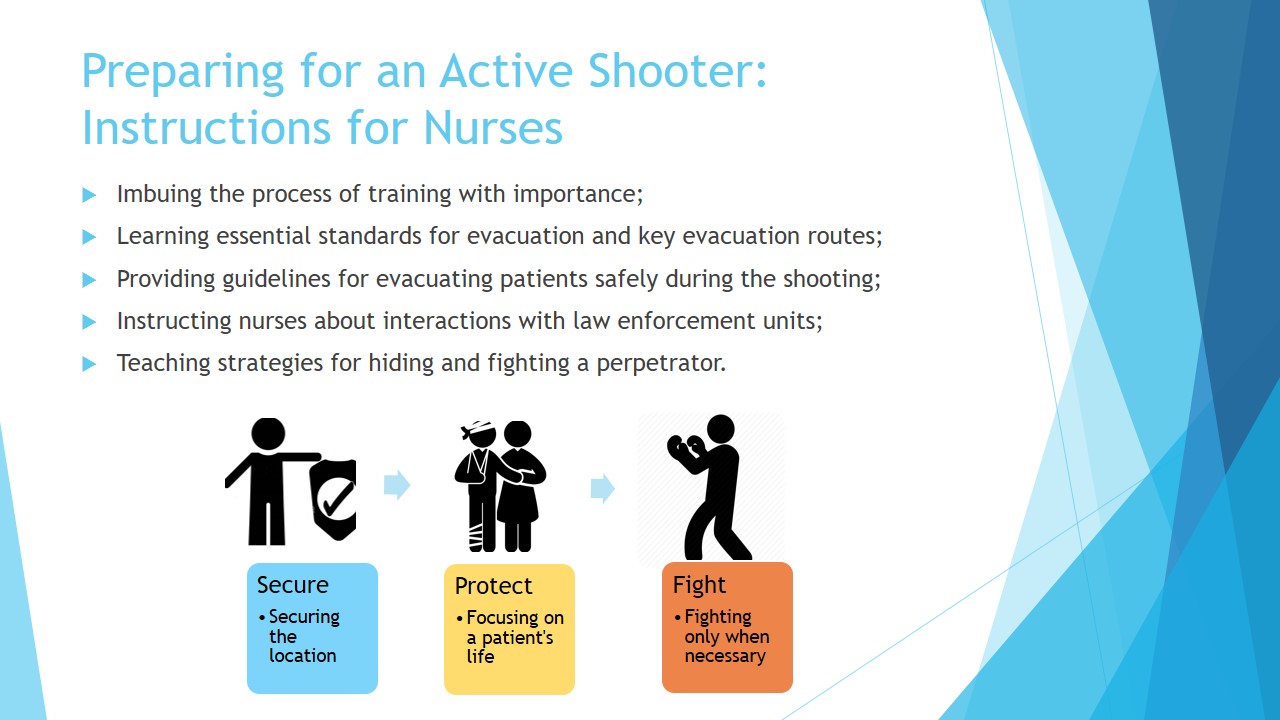
The Active Shooter Scenario: Responsibility for Patients. Protection at All Costs
- Patients’ lives: key priority for a nurse;
- The “run, hide, fight” system: active reinforcement;
- The “secure, protect, fight” model: introduction and training;
- Focus on patients’ security as the priority during a mass shooting.
Applying the threat of mass shooting to the target context, one may suggest emphasizing the importance of the corresponding guidelines by introducing a code name for them, such as “Code Silver.” The process should start with nurses about the strategies for evacuating patients immediately after a shooting has begun (International Association of Emergency Medical Services Chiefs, 2017). In the process, nurses have to be taught about the basic ways of interacting with the law enforcement unit, such as keeping hands up to avoid being mistaken for perpetrators. Similarly, nurses have to be taught strategies for hiding, as well as the methods of taking action. While the latter should be viewed only as the last resort since they suggest an immediate danger to a nurse’s life, the nursing staff has to receive basic information about the methods of incapacitating a shooter.
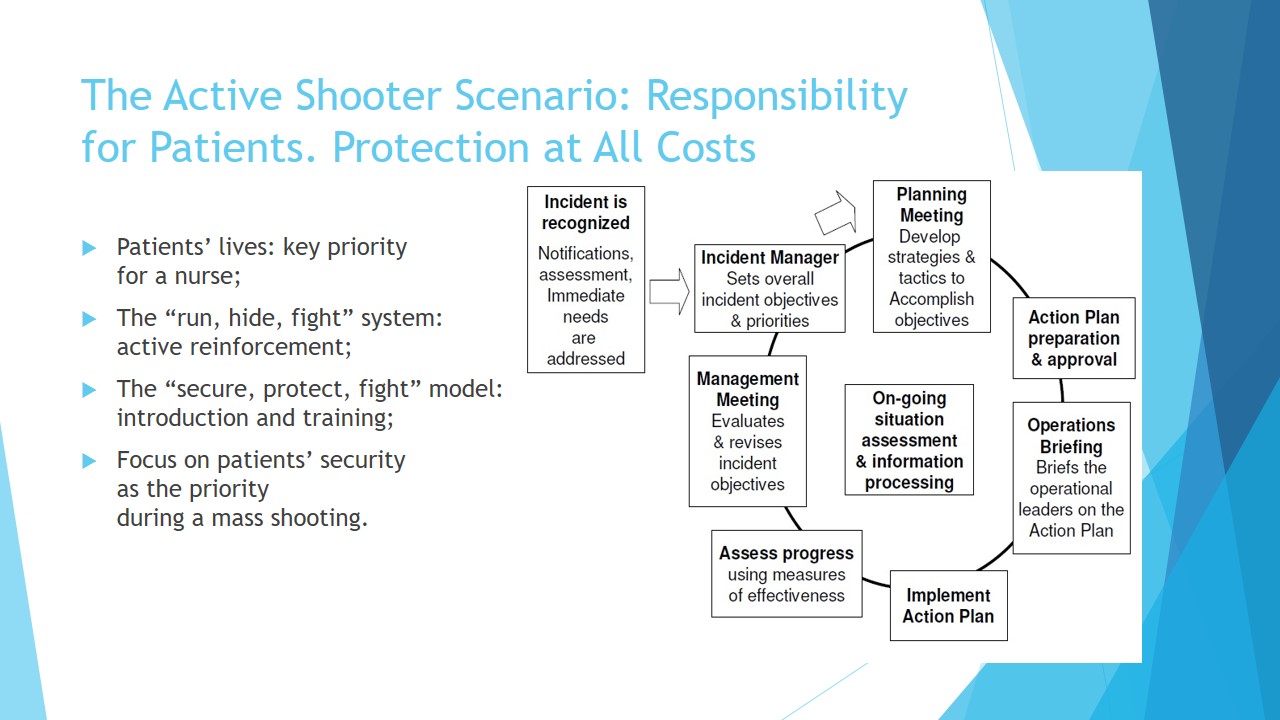
The Active Shooter Scenario: Responsibility for Patients. Ethical Choices
- Nurses, patients’ security, and personal choice: debated;
- Saving one’s own life versus saving the one of a patient: a complex dilemma;
- Impossibility to impose the necessity to sacrifice their lives during a mass shooting on nurses;
- No moral reprehensibility for nurses making a personal choice as the only solution;
- Necessity to reduce the probability of having to make a choice by meeting safety guidelines.
Currently, it is debated whether nurse should have a personal choice in a dilemma between saving their own life and the one of a patient (Jacobs and Burns, 2017). The concept of a personal choice seems to align with the existing system of rights, yet nurses should also be encouraged to ensure patient security to the maximum extent possible.
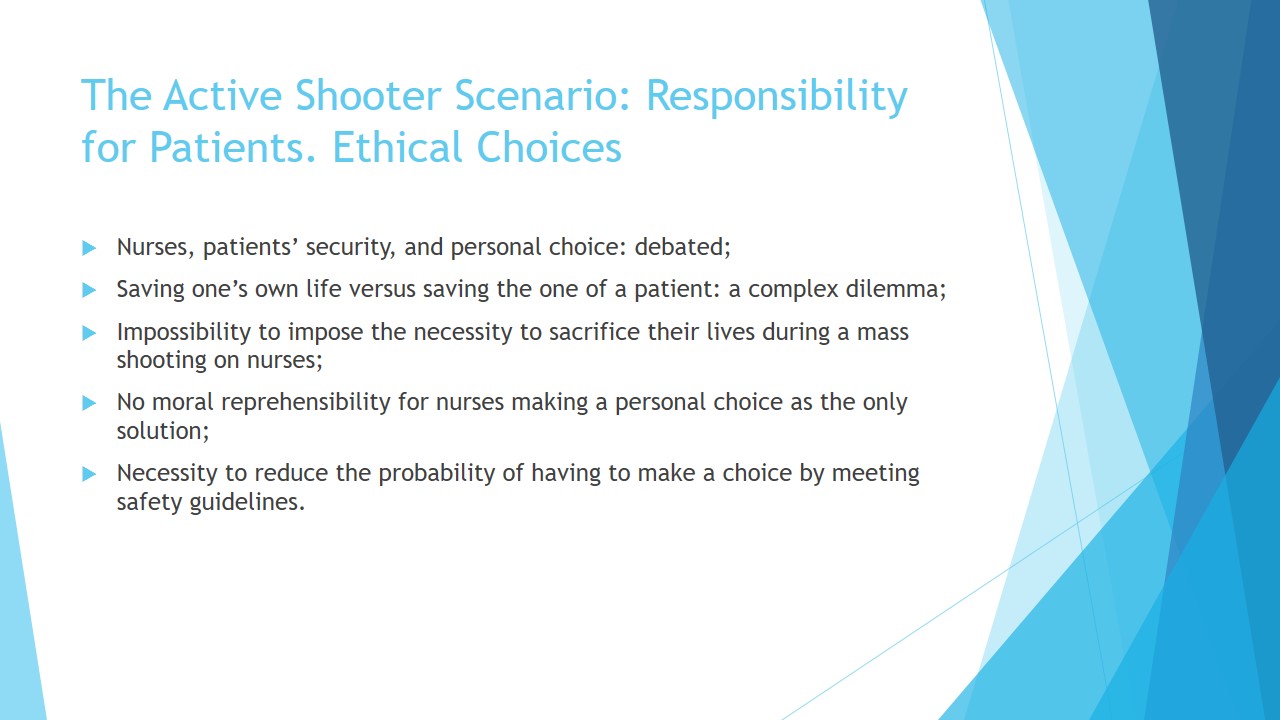
Bullying in Nursing: Examining the Code of Ethics and Hierarchy in the Workplace
- Bullying in nursing: a severe problem in the contemporary healthcare setting;
- Effects of bullying on nurses: development of health issues such as depression;
- Effects of nurses’ bullying on patients: drop in healthcare services’ quality (Berry, Gillespie, Fisher, Gormley, & Haynes, 2016).
- Potential causes of bullying in nursing: poor code of ethics, misplaced values, and unfair hierarchy.
While bullying cannot possibly be compared to mass shooting as a threat in the nursing setting, it also represents a problem to be resolved. When bullied by their peers, nurses tend to deliver services of inferior quality and develop health issues such as workplace burnouts and loss of empathy for patients (Berry et al., 2016). Researching the cause of the problem, one will encounter problems in the code of ethics established in most nursing facilities. Unless the established code of conduct addresses the issue of bullying directly and establishes tangible repercussion for it, nurses are likely to succumb to questionable practices in their interactions. In addition, a misplaced system of values lying at the foundation of the hospital hierarchy of power may cause bullying (Berry et al., 2016).
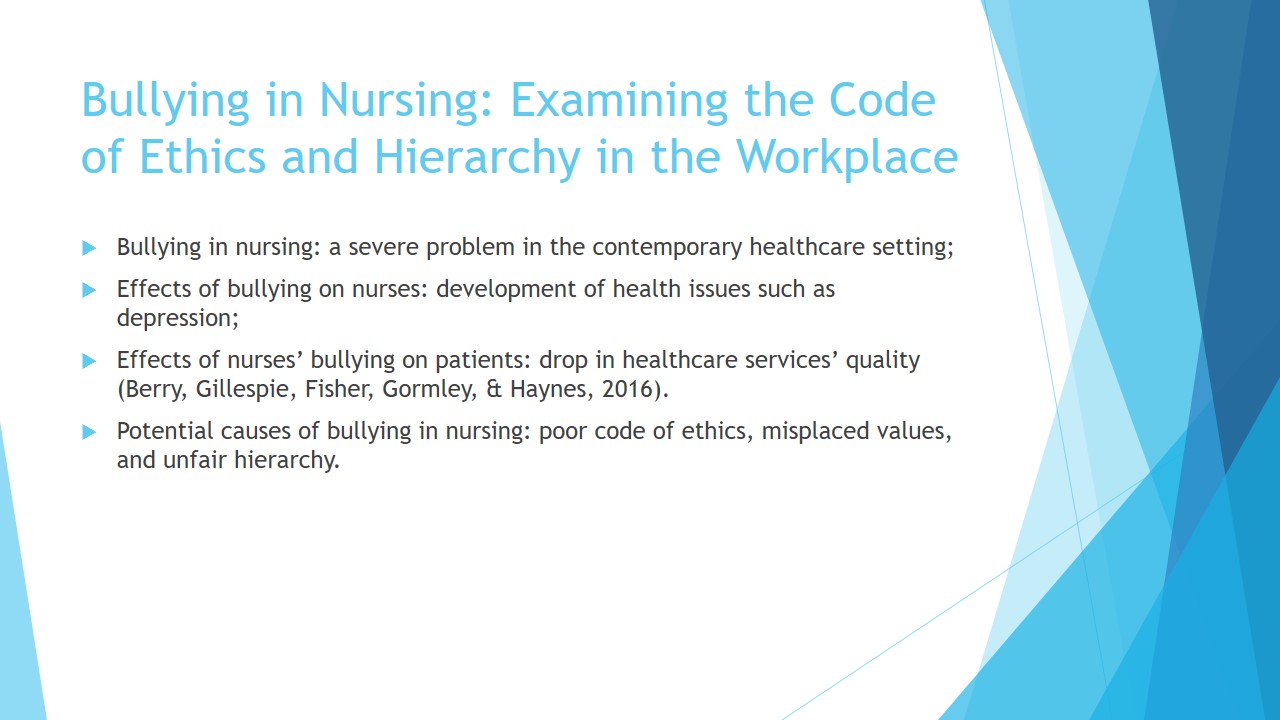
Bullying in Nursing: Lack of Awareness among Nurses as a Key Factor
- Lack of awareness of a problem causing unpreparedness;
- Nurses’ lack of response: reinforcement of the status quo;
- Nurses succumbing to bullying and participating in the hierarchy;
- Hence, the strong need to challenge the system.
Another popular factor causing a rise in bullying in the nursing environment is the absence of preparedness among nurses. Being unaware of the problem of bullies in the workplace, nurses are unable to respond adequately, which makes them succumb to the situation (Albishi & Alsharqi, 2018).
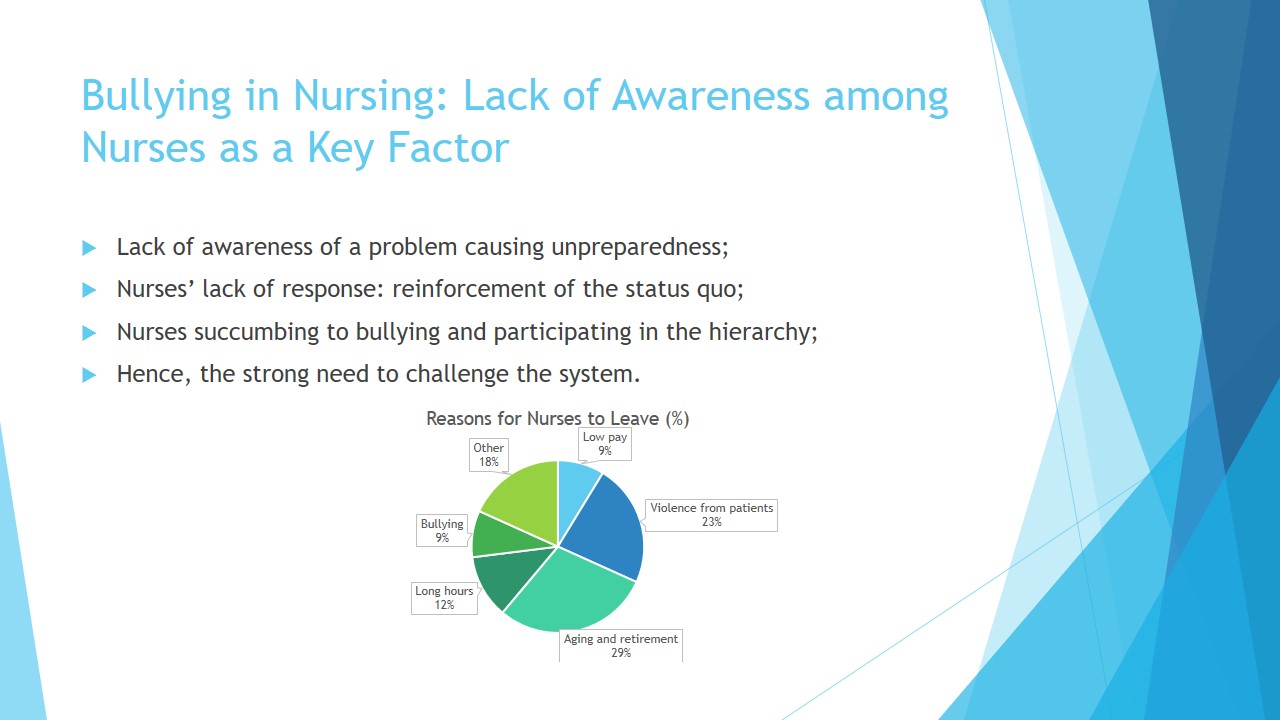
Suggestions for a Nurse Being Bullied: Informing the Manager
- Providing details about the problem in a personal conversation;
- Filing a complaint in case the issue exacerbates;
- Seeking the support of authorities (Berry et al., 2016).
Among the key steps that a nurse can take when bullied, informing a manager is the first step toward resolving the issue. The vertical structure of the hospital may impede conflict management, which is why active communication between nurses and mangers is encouraged.
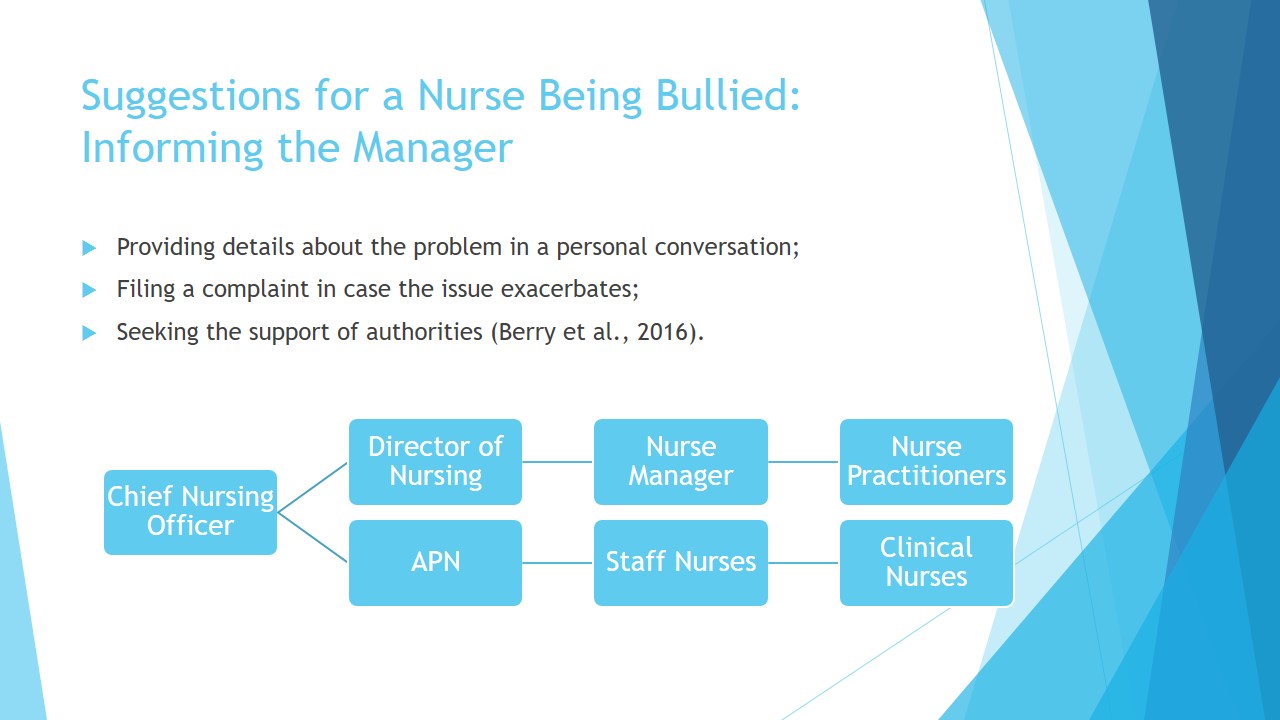
Suggestions for a Nurse Being Bullied: Learning to Fend for Themselves
- Difficulties in eradicating bullying from a nursing setting: an expected outcome;
- Suggestion: teaching a nurse to develop resilience;
- Key strategies: open refusal to play by the bullies’ rules;
- Additional approach: establishing a new mode of communication (Ulrich, Gillespie, Boesch, Bateman, & Grubb, 2017);
- Using a personal example as a model for changing the workplace environment.
Unfortunately, in a range of instances, complaining about the problem does not lead to the immediate resolution. Combined with the lack of initiative, the unwillingness to alter the status quo among the target audiences will entail the situation in which a nurse will have to learn to defend themselves. In this scenario, one will need to suggest using strategies such as stating the act of bullying, establishing no tolerance for the specified kind of behavior, and suggesting alternative options for communication.
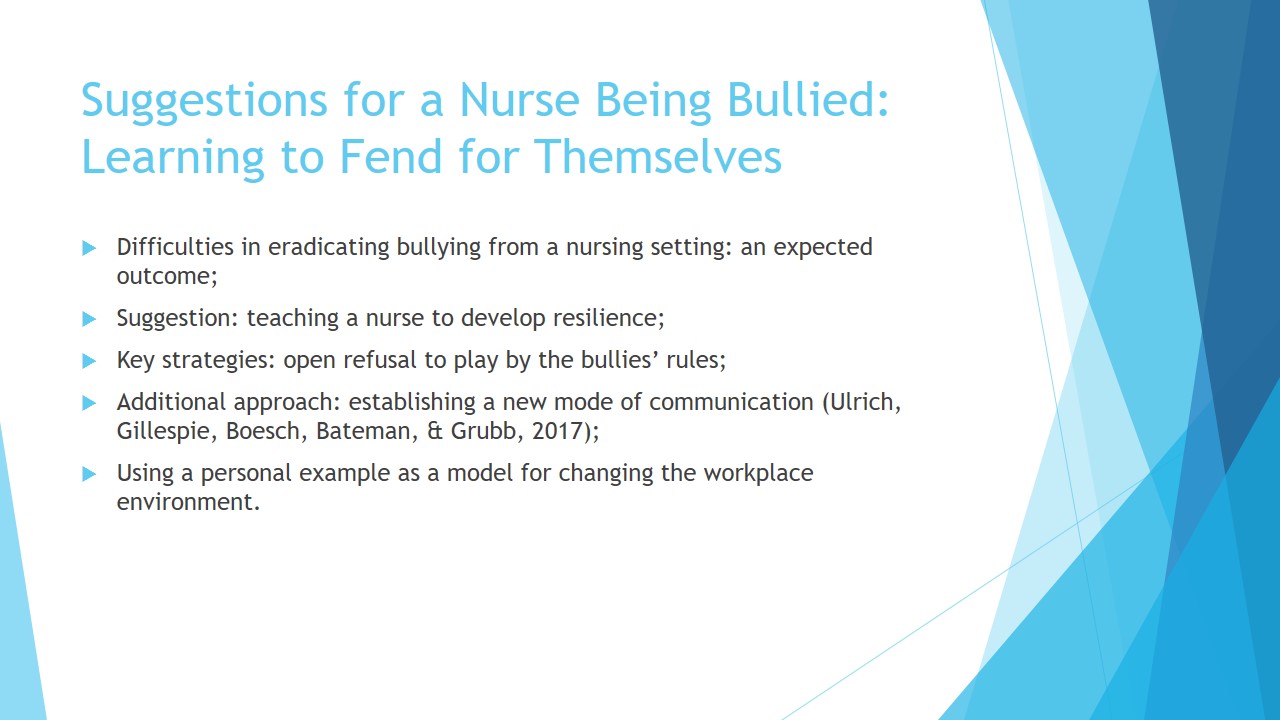
Responsibility of a Nurse: De-Escalating the Conflict
- Problem of a nurse as a team member: lack of control over workplace issues;
- Opportunities for managing bullying: de-escalating a conflict as a temporary solution;
- Use of negotiation and collaboration to make nurses focus on managing workplace tasks.
As a nurse, one has little control over workplace issues. However, to address a problem of bullying in the healthcare setting, a nurse may consider seeking the strategies for de-escalating a conflict as a short-term tool. Thus, one will reduce the pressure experienced by a victim and provide the latter with the time needed to develop a resilience-based approach.
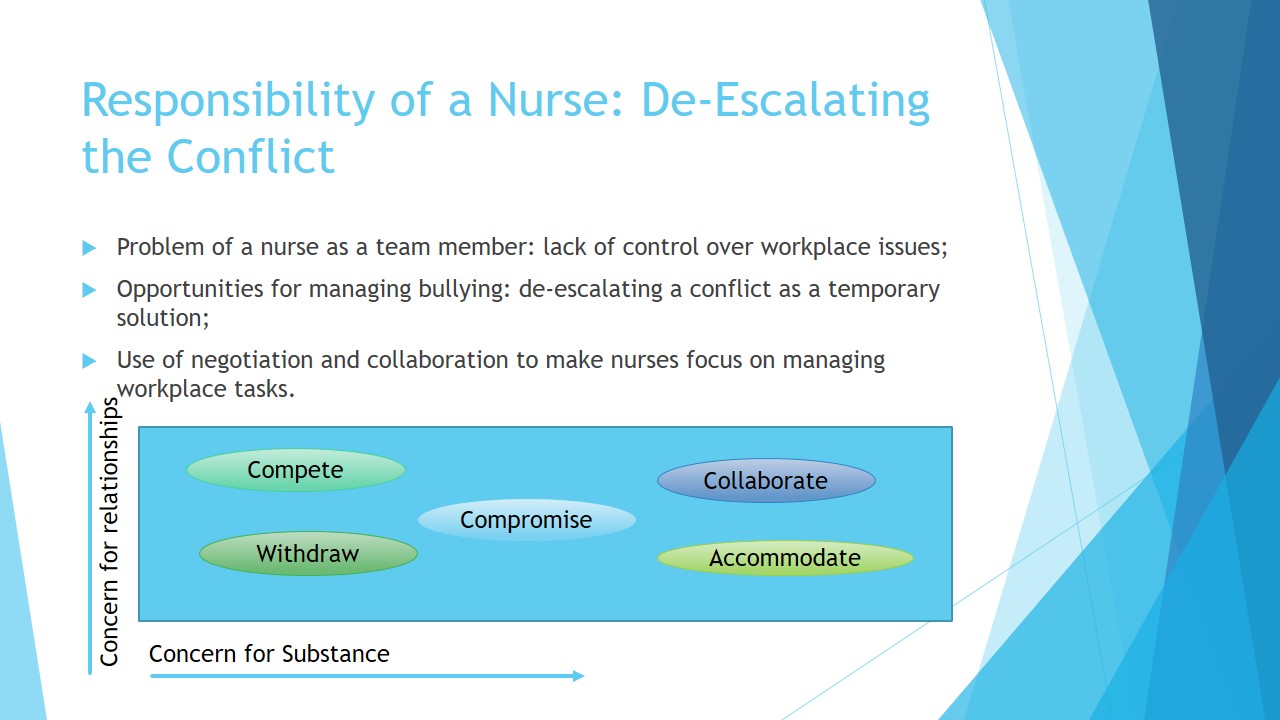
Responsibility of a Nurse: Changing the Workplace Environment
- Long-term objectives in addressing bullying: changing the workplace culture;
- Using a personal example as a role model for others to follow;
- Revisiting ethical standards and values constituting the basis for communication;
- Promoting equality, respect, and conflict management techniques.
In the long term, a nurse may consider shaping attitudes and behaviors in the workplace. The described goal may seem unrealistic for a nurse that does not have a leadership power, yet the introduction of a personal model as the tool for building relationships in the workplace may become a solution. Thus, one will introduce staff members to a set of new values such as equality, respect for peers, and the ability to manage conflicts productively.
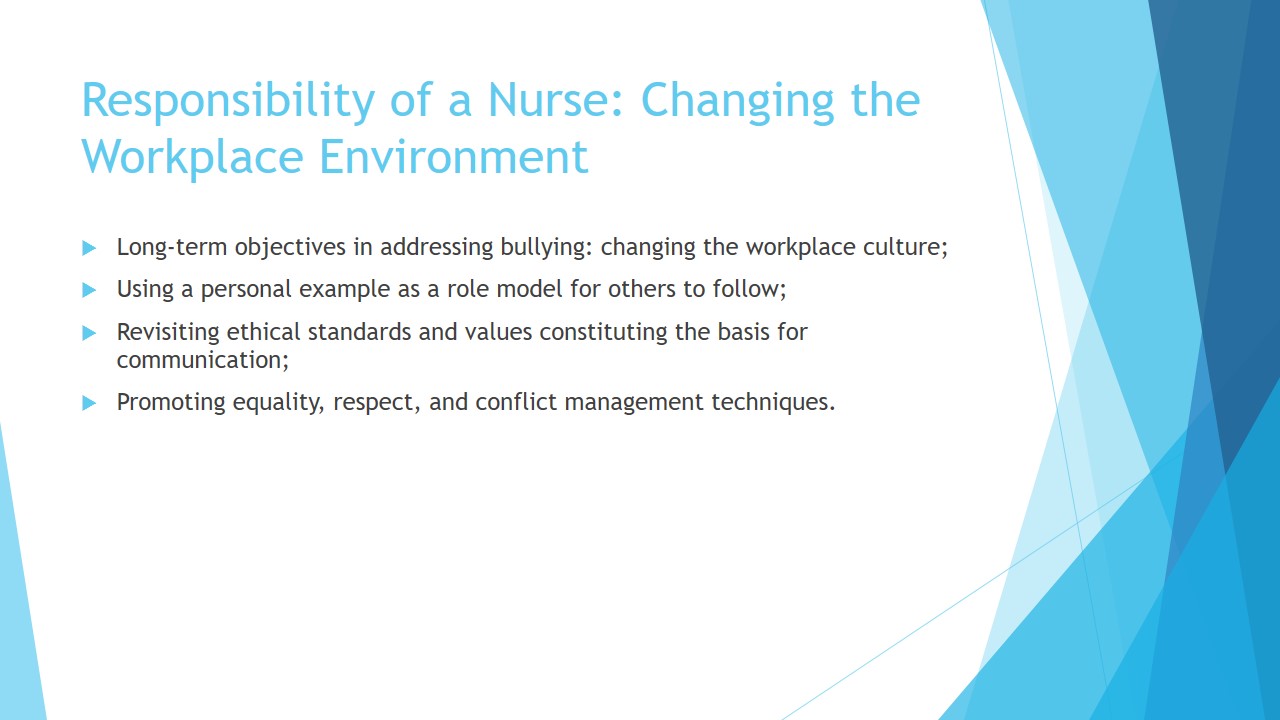
References
Albishi, E., & Alsharqi, O. Z. (2018). Factors counteracting nurses’ bullying in healthcare organizations: An applied study in King Abdul‐Aziz University Hospital in Jeddah Province. Journal of Nursing Education and Practice, 8(10), 20-35. Web.
American Nurses Foundation. (2019). Spring 2018 nurse survey. Web.
Berry, P. A., Gillespie, G. L., Fisher, B. S., Gormley, D., & Haynes, J. T. (2016). Psychological distress and workplace bullying among registered nurses. OJIN: The Online Journal of Issues in Nursing, 21(3), 4. Web.
Federal Bureau of Investigation. (2019). Active shooter incidents in the United States in 2018. Washington, D.C.: U.S. Department of Justice.